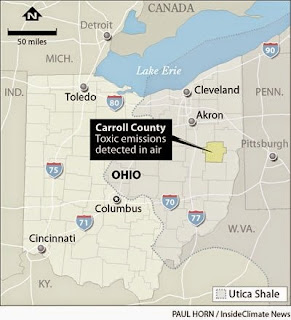A new study has found unsafe levels of
polycyclic aromatic hydrocarbons (PAHs), linked to cancer and
respiratory illness, near fracking sites in Carroll County, Ohio.
The study, published in
Environmental Science and Technology,
was conducted by a research team headed by Drs. Kim Anderson of Oregon
State University and Erin Haynes of the University of Cincinnati.
The first author was Blair Paulik, an OSU graduate student. The
article is gated, but secondary sources, including
an OSU press release, give what appears to be a complete, though non-technical,
description of the study.
Carroll County, 70 miles southeast of
Cleveland, has 30,000 residents, lies on the Utica Shale formation,
and had 421 natural gas wells at the time of the study, February
2014. (It now has 480.) The study was
initiated by concerned citizens who contacted Dr. Haynes.
Air samplers were placed on the
properties of 23 volunteers who lived within 3 miles of gas wells. The
monitors contained treated materials that absorbed contaminants.
They were sealed in airtight bags and shipped to Dr. Anderson's lab
for analysis. Volunteers were trained in proper collection and handling of the
data.
PAHs are hydrocarbons (compounds of
carbon and hydrogen), seven of which,
i.e., benzopyrene, are
classified by the Environmental Protection Agency as carcinogenic.
Prenatal exposure is also associated with lower IQ and childhood asthma.
Based on their data, the authors calculated that the lifetime cancer risk
for those living closest (.1 miles) to the wells is 2.9 in 10,000.
This is almost three times the EPA's acceptable level of 1 in 10,000.
Levels of PAHs declined 30% at a distance of three miles—still
well above the acceptable limits. Levels were about 10 times higher
than a rural Michigan county containing no gas wells.
 |
Researcher Blair Paulik in front of an air
sampler
(© Oregon State University)
|
In googling the study,
I found an article in
Marcellus Drilling News, a pro-fracking website,
calling this a “sham study.” Some of their objections were
silly,
i.e., that the OSU authors were “a long way from
home,” and that the article “sneaks in the c-word.” (Estimating cancer risk was the point of the study.) I found three possibly substantive criticisms: that there were too few
data collection sites, that they were not randomly distributed throughout the county, and
that the data were collected by “untrained volunteers.” The
third objection is false, but if the samples were carelessly handled,
it's likely they would have captured fewer, not more, contaminants.
Since neither the gas wells nor the human population are randomly
distributed within the county, I doubt the value of including data
from locations that are far from either gas wells, people or both
(although it certainly would have diluted the findings).
Future studies should randomly select
fracking sites and collect more samples at varying distances
from the wells, including some more than 3 miles away, to establish
the physical boundaries of the contamination.
You might also be interested in reading:










